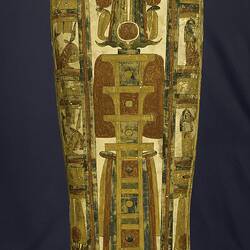Summary
The decorated wooden coffin of Nytamenkhamun (sometimes written Tamenkhamun), is the only significant Egyptian antiquity to enter the collection in recent times. It was acquired from the collection of J. Bedford, a postmaster at Kyancutta in South Australia who had a small museum. Inscriptions on the coffin note that Nytamenkhamun was a seventh century BC minor official in the administration of property owned by the temple of the god Amun at Thebes.
The Coffin of Nytamenkhamun (Effectiveness belongs to Amun)
Acquisition date: 1972. Purchased from the Kyancutta Museum, South Australia, estate of Robert Arthur Bedford.
Acquired by Bedford prior to 1915 but after 1910 from the sale of the collection of Sir George Newnes by Sotherby's of London; dispatched to Australia circa 1923. Newnes probably acquired the piece either from a sale in London or in Egypt itself, which he visited several times late in his life for health reasons.
Owner: Nytamenkhamun (sometimes written Tamenkhamun), overseer/manager of a storeroom of the Temple of Amun; son of Nesykhonsu (He belongs to Khonsu), manager of a storeroom of the Temple of Amun, and Tashesep. Father and son held the same position and were minor officials in the administration of the estates belonging to the temple of Amun.
Provenance: Ancient Thebes, modern Luxor in the south of Egypt. The identification of the place of manufacture of the coffin and the location of Nytamenkhamun's burial as Thebes is based upon several factors: his name and that of his father venerate gods of that city; they held positions in the administration of the property of the temple of Amun, whose main cult centre was Thebes; aspects of the decoration are the same as those on coffins found in Luxor. A detail of the collar, showing two red bands on either side of the head of the ram-headed bird, relate the coffin to a small group of other coffins with this same feature (one of which is in the Nicholson Museum, University of Sydney) and indicates that they were all probably made in the same workshop.
Date: Dynasty (family of kings) XXV (circa 725-664 CE); this date is based upon aspects of the iconography and the writing of certain words.
Description:
A bi-valve, wooden coffin, covered with plaster and decorated in polychrome.
The owner is shown mummiform with a red face, indicating his sex, and wearing a lappet wig and a large floral and bead collar; originally a long narrow beard was attached below the chin. On the top of the head is a scarab beetle, identified as Lord of Heaven.
Below the collar is a ram-headed bird above a falcon, both of which are identified as Behdet, the sky god. On either side of the first of these are panels with a rearing cobra wearing the white crown of Upper Egypt behind a figure of Nytamenkhamun who makes offering to Osiris, god of resurrection. In the register below the jackal-headed Anubis, protector of cemeteries and patron of embalmers, is depicted. Between the registers is a line of inscription with a prayer to Behdet to grant offerings to the deceased.
The upper part of the coffin is divided from the lower by a horizontal line of text containing the standard prayer to Osiris to grant offerings to the deceased in his next life. Below the inscription in the centre is the symbol of Abydos, the cult centre of Osiris in Upper Egypt, wearing tall plumes, flanked by two registers. In the upper one the Four Sons of Horus each carrying knives are depicted, two on each side. Horus is the son of Osiris, and his sons were assigned the task of protecting the internal organs (liver, lungs, intestines, stomach) removed during the process of mummification. In the lower register are falcons with their wings outstretched in a gesture of protection. The intervening line of text contains prayers to the earth god Geb, prince of the gods. Separating these panels from the central image are vertical lines of inscription on a white ground that give the names of the coffin's owner and his parents. In the lowest section of decoration on the body Nytamenkamun is shown as a mummy lying on a lion-headed bed, with three vessels containing sacred oils below; a seated bird is shown above the body, probably representing the soul (Ba) of the deceased, and a brazier with incense burns in front of the bed to purify it. On the coffin's foot the text again contains a prayer to the deceased and names his parents and the base section depicts the sacred bull Apis carrying a figure of the deceased. The decoration on the base of the coffin which, as with the lid, is restricted to the outside, is dominated by the representation of the djed-pillar, a symbol of the resurrected Osiris, and large floral bouquets.
The decoration of the coffin ensures that Nytamenkhamun would be resurrected into the next life. The imagery draws upon and merges two main belief systems: one focusing upon the god Osiris, who triumphed over death and belief in whom ensures a second life and resurrection, emulating that of the god himself, and the other upon the various forms of the sun god, the creative force behind the universe. Behdet is represented twice, once with the head of a ram and body of a bird, thus incorporating the god Amun into the system, as the ram was one of the animals sacred to that god. The scarab beetle represents Khepri, the sun rising from the horizon at dawn having triumphed over the forces of evil during the night. The repeated occurrence of Nytamenkhamun's name assists his survival and identity in the next world, and the existence of his mortal remains are ensured by the representation of his body, shown being united with his soul.
More Information
-
Keywords
-
Localities
-
Authors
-
Article types

